Our Roots Are Still Alive - Chapter 14
Previous: Chapter 13
Table of Contents
Next: Chapter 15
New Jersey Solidarity-Activists for the Liberation of Palestine Main Site
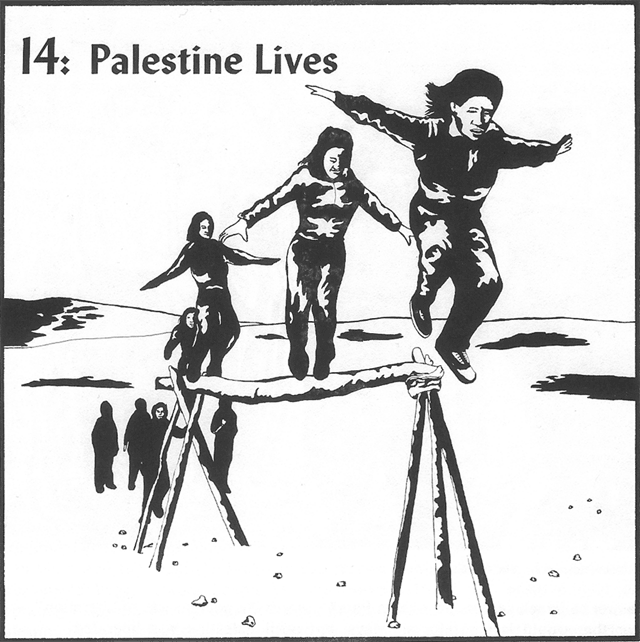
- Each land has its own rebirth
Each dawn has a date with revolution.
- Mahmoud Darweesh
In the summer nights following the June War, Israeli tanks and jeeps prowled the streets of the occupied West Bank and Gaza Strip. Israeli soldiers frequently stopped Palestinians for rough questioning. Any hint of defiance could lead to further questioning behind the closed doors of the nearest prison. The first Israelis to move into the occupied territories were the prison officials, the military administrators, and the Shin Beth - the Israeli secret intelligence service. Their job was to seek out any possible Palestinian resistance and eliminate it.
Yet, except for these Israeli authorities, most people in the West Bank town of Nablus knew that Yasser Arafat, a Fatah leader, sat at a certain local cafe each day, talking with townspeople. Like many Palestinians that summer, Arafat discussed the meaning of the shattering defeat of the June War. He and other members of the armed resistance were recruiting Palestinians to fight Israeli occupation. The only answer to Israeli aggression was, in Fatah's words, "a popular war of liberation" -a war that would last not for six days, but until Palestine was liberated.
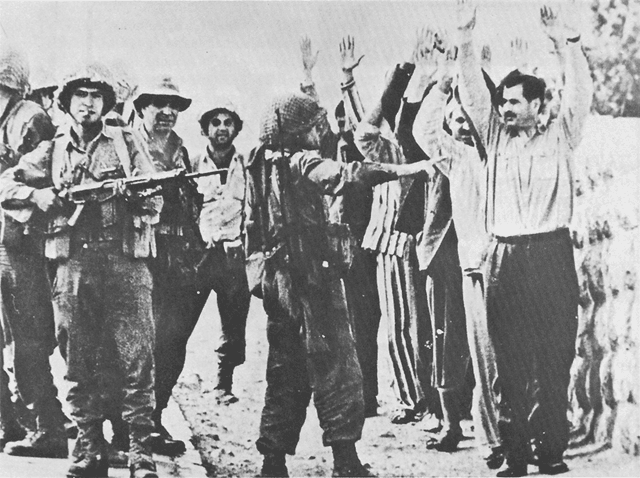 Israelis round up "trouble-makers" in Gaza.
Israelis round up "trouble-makers" in Gaza.
The Israelis did not allow the guerrillas to organize so openly for long. By midsummer the net of repression was closing in on fedayeen in the West Bank and Gaza. Captured Jordanian files gave the Israelis the names of suspected guerrilla sympathizers, and mass arrests began. In August, Fatah began attacking Israeli soldiers in the West Bank. In December, the Popular Front for the Liberation of Palestine (PFLP) - a Marxist organization formed from several guerrilla groups with roots in the Arab Nationalist Movement - also began raids. At first the guerrillas' losses were high. Israeli newspapers boasted of the numbers of fedayeen killed or captured. Fatah explained the movement's way of looking at these actions:
- We did not understand the struggle in terms of profit or loss. We blow up one bridge and the Zionists will blow up ten of our bridges.... We must plant it firmly in our minds that the strategy is that of a guerrilla warfare which should be developed into a popular war of liberation.... This is mainly what frightens Israel, Zionism, and other counter-revolutionary forces. Why? Because calculations will not be made on the basis of a tank for a tank and a combat plane for a combat plane. The calculations are based on the will of a struggling people who want to fight...1
Israel planned to break the Palestinians' will to fight by harsh repression of all political activity. By early 1968 the Israeli crackdown had driven most identifiable guerrillas out of the occupied territories and into Jordan and Lebanon. Those who stayed had to work as part of an underground movement. The Israelis not only outlawed political activity, but also attacked Palestinian economic and social institutions. They shut down Arab banks, schools and hospitals in the West Bank and Gaza, replacing them with Israeli institutions. The Israelis used threats when necessary to convince West Bank "notables" who had loyally served Hussein as village officials to switch their allegiance to Israel. Others transferred their loyalties without prompting.2
Israel planned to keep the rest of the population in line by a combination of force and the creation of a colonial mentality among the people. Schoolteachers in the West Bank and Gaza were forced to teach Palestinian children courses that glorified the history of Israel and belittled Arab culture. Teachers who protested were fired. One who was exiled to Jordan in 1967 said, "I can't teach that Palestine was always Jewish and we are parasites."
The crowded refugee camps of Gaza were largely isolated from outside reporters and contacts. There the Israeli drive to create a passive population took its most brutal form. Heavily-armed Israeli patrols descended on the camps and cities and rounded up people indiscriminately. In one such roundup in late 1967, Israeli soldiers forced two thousand men to lie half-submerged in a lake for twenty-four hours during a storm. Other "troublemakers" were exiled to concentration camps in the Sinai Desert.3 Still, Israeli soldiers rarely dared to leave their jeeps as they patrolled Gaza. Wires stretched across the road at windshield level often caused their jeeps to screech to a halt. In 1968, two hundred women defied a law forbidding demonstrations and marched on Gaza prison, demanding the release of two thousand Palestinian prisoners.
In Gaza and the West Bank and in the refugee camps in Jordan and Lebanon Palestinians began taking action for themselves toward the positive goal of liberating Palestine. Slowly they broke out of the defeatism that had gripped many Palestinians - a defeatism that the Arab governments had fostered in them. They began to fight against the "vengeance mentality" toward Israel which some still held on to - what Fatah called the "venom and bitterness of an oppressed people who see no way to freedom." The guerrilla organizations led the fight for these changes.
In Fatah's first communique after the June War, the guerrillas emphatically rejected the leadership of PLO figurehead, Ahmed Shukeiry. During the war, Shukeiry had broadcast tirades on Cairo Radio that vowed to "drive the Jews into the sea." Fatah condemned this racism toward Jews:
- [Palestinian] operations ... are in no way aimed at the Jewish people. Nor do they intend to "drive them into the sea". ...[O]n the day the flag of Palestine is hoisted over their freed, democratic peaceful land, a new era will begin in
which the Palestinian Jews will again live in harmony, side by side, with the original owners of the land, the Palestinian Arabs.4
In December 1967, Fatah, the Popular Front, the General Union of Palestinian Students and other groups joined in a condemnation of Shukeiry. He was removed from the leadership of the PLO for his "misleading statements" and his backward leadership.5 In Shukeiry's place, the fedayeen emerged as the real leaders of the Palestinian struggle.
Karameh Means Dignity
Three months later the guerrillas demonstrated the new strength of the Palestinian movement to the Arab people and Israel. In the small Jordanian town of Karameh the fedayeen waged a battle that galvanized the support of the Palestinian people for its fighters. Karameh, which means "dignity" in Arabic, had been patiently built by Palestinian refugees from a tented refugee camp in 1952 into a prosperous town that supplied vegetables and poultry to the whole region. Twenty-five thousand more refugees swelled Karameh in the months after the June War, The people of Karameh supported the fedayeen and many joined their ranks. The town became a base for guerrilla raids into the West Bank. In the first two months of 1968, the Israelis attacked Karameh from the air, shelling the town six times. Knowing the Israelis would eventually attack the town, the guerrillas moved much of the population to the mountains and prepared for battle.
Four Israeli armored columns attacked Karameh on March 21, 1968. They expected the guerrillas and their supporters to scatter. Instead, Fatah leaders decided that the guerrillas would make a stand. Inside Karameh, two hundred guerrillas, all volunteers, fought for twelve long hours, holding off the more numerous and far better equipped Israelis. Taher Saadi, a fighter who survived the battle at Karameh, told a French reporter why the Palestinians stayed in the embattled town:
- At Karameh, the Israelis had tanks and planes; they were trying to crush the fedayeen.... Many of our men who had run out of ammunition hurled themselves under the tanks, carrying explosives. The first martyr to do that was Rarbi; he threw himself under a tank. I knew him well. We stuck it out that day, so as to wipe out the memory of June 1967.6
Overnight the fedayeen became heroes in the Arab press. The next day photos of burned-out Israeli tanks appeared in newspapers throughout the Arab countries. Palestinians had done what the Arab leaders could not do - stand up to the military might of Israel. Arab leaders rushed in to stake out part of the victory for themselves. Even King Hussein, dressed in battle fatigues, went to Karameh and had his picture taken beside a captured Israeli tank. He declared, "We are all fedayeen."
For exiled Palestinians in Jordan and Lebanon, the victory at Karameh was more than a media image. It was a seed dropped on fertile soil. As Palestinian farmers defied Israeli shelling and moved back to the ruined town of Karameh to plant new crops, thousands of young volunteers clogged the guerrilla recruiting stations in Jordan. In the lines were Palestinians who had given up jobs as postal clerks, farmers, engineers or secretaries to offer their lives to liberate Palestine. At first many had to be turned away because there were not enough arms to hand the eager fighters.
Many of these recruits came from the refugee camps in Jordan and Lebanon where hundreds of thousands of Palestinians still lived. Among those who had come to the camps after the June War there was a special energy to be tapped. In 1968 and 1969 activists from all the guerrilla groups moved into the camps to help organize them and to explain the lessons of people's war. They recruited new members, organized militias and discussed politics with the eager and the skeptical.
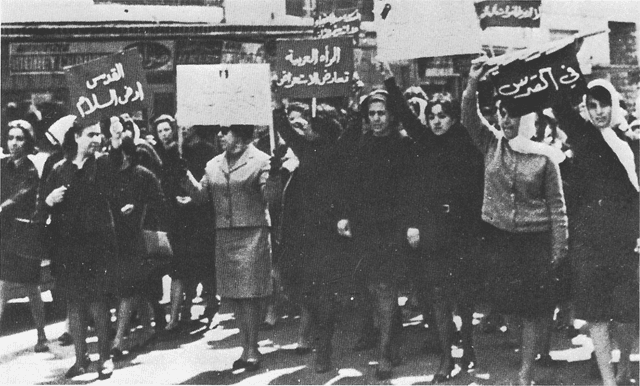 Women march against an Israeli military parade through the occupied territories, Jerusalem, 1968.
Women march against an Israeli military parade through the occupied territories, Jerusalem, 1968.
The guerrilla groups set up schools in the camps to teach the children to be proud of, and learn from, Palestinian history. One Fatah leader, a former teacher in the UN-sponsored schools, explained with a quiet passion to an American interviewer that, "The UNRWA schools are trying to destroy this generation of our children." His stories of out-of-date textbooks or no books at all, irrelevant studies and overcrowded classrooms reminded the American of ghetto schools in the United States. The Fatah leader said, "Of course, the same people plan it, the same people are responsible for it. The U.S. government runs UNRWA."7
The guerrilla schools gave military training as well as explaining the history and geography of Palestine, and teaching fundamental skills like reading and writing. In camps in Jordan and Lebanon, young boys and girls learned to crawl through barbed wire fences and jump hurdles, chanting together, "To Palestine!" A Palestinian mother commented:
- I am proud to see that our children are able to do that. I am only sorry that it is necessary that they should do it.... As one of our songs says, "I am fighting so that the future generations will reap the wheat."8
To Liberate Women Is to Liberate Society
The military training of young girls in the guerrilla schools was an example of one of the most profound changes brought about by the Palestinian revolution: the new role of Palestinian women. All the guerrilla groups recognized that Palestinian women were one of the deepest resources for revolution, and they affirmed that the liberation of women was fundamental to the liberation of Palestine.
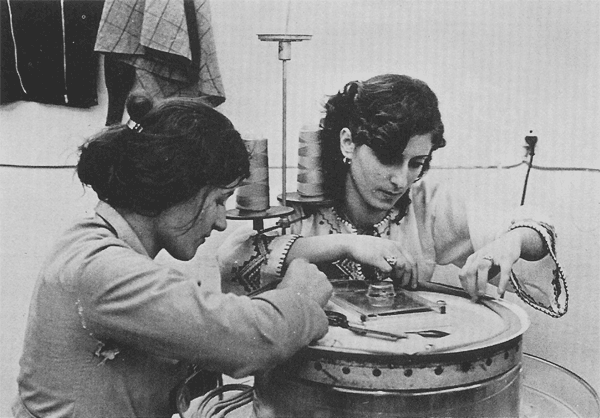
Women working in a resistance center.
Palestinian women won this recognition by fighting for it. In the 1936 revolt, the war of 1948, and the guerrilla war of the 1960s, Palestinian women took up arms. Isam Abedilhadi, president of the General Union of Palestinian Women (founded in 1965), described the role of women in resisting Israeli occupation:
- Concerning the women after 1967, they were the first to lead demonstrations asking for withdrawal, rejecting occupation, asking for something. They were the first prisoners. They were the first to ask for strikes. Won't we all be put in jail or be deported? Well, it's all right.... I was in prison and there were more than five hundred women in all the prisons, inside the occupied territories, and twenty-five of them were deported.9
Even as women fought and demonstrated, a daily struggle was going on in Palestinian homes between men and women of the Resistance and the traditional heritage of old Palestine, with it strict ideas of how to protect women's honor. Women had to argue with their families to be allowed to go alone to political meetings, to take military training or to stand guard duty. Islamic culture taught that women couldn't work outside the home and retain their honor. Yet women wanted and needed to work to support their families and the revolution. Slowly, the traditional notion of women's honor, which rested on obedience and chastity, began to crumble. A new concept of honor, forged in the crucible of revolution, began to emerge. It valued the contribution of women to the movement, and to other women's growth and development.
Women's centers in the refugee camps helped women overcome the stumbling blocks to their participation in the revolution. In Jordan, where only 15 percent of the women could read, grandmothers patiently stumbled through their first book with the help of a young guerrilla. These centers also trained women in sewing and marketed their products. "When a woman has money that she herself has earned," said a woman in a sewing center in Irbid, "she can speak more loudly in her own home."10
Not only Palestinian women, but all Palestinian workers and peasants in Jordan were finding their voice and speaking out against the injustices of Jordanian society. Unions had always been illegal in Jordan, and workers who tried to organize them were quickly imprisoned. When the Palestinian Resistance began organizing in Jordanian workplaces, the number of strikes increased dramatically. When police came to break up the strikes, they were often met by armed guerrillas. Employers were forced to recognize the unions their workers wanted. The guerrillas also supported Palestinian sharecroppers in disputes with their Jordanian landlords over the size of annual rents. Slowly more Jordanians began to support the Palestinian liberation movement.
Confronting the Arab Regimes
Before King Hussein's eyes, the seeds of a new society were sprouting and threatening his rule. Jordanian officials watched as goods stamped "For the Palestinian Nation" arrived at Amman. Aid from Vietnam, China, Algeria and other liberation movements around the world flowed into Jordan. In Amman guerrillas maintained their own military checkpoints, newspapers and offices. King Hussein knew that the Palestinian movement would like to see him overthrown. After all, the British had artificially carved Jordan from historic Palestine after World War I, and his grandfather had annexed the West Bank in 1948. Most of Jordan's population were Palestinians who had never strongly supported Hussein. His regime depended on American economic and military aid for survival, as his grandfather's had on British support. The U.S. government paid half of Jordan's annual budget and the CIA made personal payments to him starting in 1957. Hussein used much of this money to pay large salaries to his army, made up of impoverished bedouins whom he had turned into loyal troops.
Hussein could not tolerate the growth of this Palestinian nation within his kingdom. He decided to act quickly to protect his throne. On November 4, 1968, Hussein's soldiers opened fire on Palestinian offices in Amman and on three refugee camps. They killed several campdwellers, but the fedayeen repulsed the attack. Hussein's troops had to retreat and await a better time to strike. After Hussein's November raid, Fatah warned its Arab enemies that the Resistance was "not prepared to commit suicide with Arab bullets."11
President Nasser of Egypt refused to condemn the November attack, claiming he did not want to violate "Jordanian sovereignty." The refusal of even the most progressive Arab states to criticize Hussein opened a serious debate between the guerrilla organizations on the role of the Arab governments in the Palestinian struggle. The debate highlighted the central dilemma of the Palestinian movement: as a people driven off their land, they had no secure base in which to train and organize. Access to the camps in the East Bank of the Jordan and southern Lebanon was vital for the growth of the Resistance and the fight against Israel. What price should the guerrillas pay to maintain their freedom of movement in the Arab countries? How should the fedayeen relate to radical movements in the Arab countries? The major organizations in the Resistance debated these questions throughout 1969.
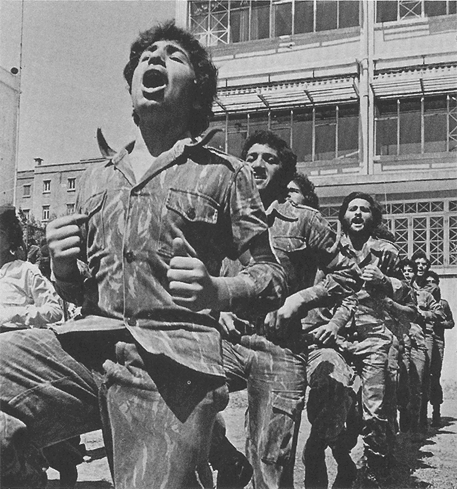
Youth training in a Palestinian camp.
Fatah was convinced that the revolution could not publicly challenge the internal structure of the Arab states without losing its base of operations. Its suggested policy was "no meddling in the internal affairs of Arab countries." Zionism was the first enemy; change in the Arab countries would come after Palestine was liberated.
The Popular Front believed equally as firmly that the liberation of Palestine went hand in hand with radical changes in the Arab governments. In this view, the overthrow of Hussein and the establishment in Jordan of a democratic state was a pressing task. The Democratic Front for the Liberation of Palestine (DFLP), which broke from the Popular Front in 1969, argued that the Resistance should not even accept aid from regimes like Egypt. Both the Popular Front and the Democratic Front believed that the only reliable allies of the Palestinians were the small revolutionary movements in the Arab countries.
Differences in military strategies also developed between the Popular Front and Fatah. Fatah confined its operations to Israel and the occupied territories. The Popular Front, although also operating in the occupied territories (especially Gaza), took the cause of the Palestinian people to the world arena. Its most spectacular actions were hijackings of U.S. and Israeli planes in 1968 and 1969. Leila Khaled, a Popular Front commando who participated in hijackings, explained the strategy:
- We do not embark haphazardly on adventurous and romantic projects to fulfill "individual needs".... We act collectively in a planned manner ... to dramatize our own plight and to express our resolute determination to alter the "new realities" that Mr. Moshe Dayan's armies have created.... [We act] with a view to disseminating revolutionary propaganda ... making our cause international ... before an unresponsive Zionist-inspired and Zionist-informed Western public opinion. As a comrade has said, "We act heroically to prove that the enemy is not invincible.12
And Israel was not invincible. The fedayeen raids grew more frequent and more effective throughout 1968. Targets included the Haifa pipeline, a potash factory near the Dead Sea, para-military settlements, and factories in Tel Aviv. By 1969 about three hundred guerrilla actions were occurring inside Israel and the occupied territories each month. By 1969 two thousand Israeli casualties had resulted from raids since the June War. Israel responded with a heavy counterattack.
In December 1968 Israel answered a hijacking by blowing up thirteen passenger planes in Beirut, Lebanon. In 1969 it began a steady campaign of saturation bombing in southern Lebanon. Saturation bombing hits everything indiscriminately - fields, sheep, and farmers, as well as guerrilla bases. The Israelis hoped the bombings would pressure the Lebanese government to move against the guerrillas. The right-wing government did order the army to attack the refugee camps. But strong resistance by the Palestinians and strikes and demonstrations by their Lebanese supporters forced the Lebanese government to back down. After Egyptian mediation, the Palestinians and the Lebanese government signed the Cairo Accords, which guaranteed the Palestinians' freedom of movement inside Lebanon and control of the refugee camps in exchange for non-interference in Lebanon's internal affairs. This was a major defeat for Israel's plans.
The Zionists suffered another political defeat in 1969 when Fatah and the other guerrilla organizations took control of the Palestine Liberation Organization. From the beginnings of the Palestinian armed resistance, King Hussein of Jordan and the Israeli authorities in the West Bank and Gaza had repeatedly tried to deny the Palestinians the right to their own representative organization. Since its creation in 1964, the PLO had been largely under the control of the Arab governments. But at the Fifth Congress of the Palestine National Council - the highest authority of the PLO - several hundred representatives came from trade unions, women's and student organizations and, for the first time, most of the guerrilla organizations. They chose a new leadership for the PLO Executive Committee, the body which carries out the programs and goals of the Council. This new leadership reflected the success of the armed resistance movement in winning the support of the Palestinian nation. Fatah won the majority of the seats, and Yasser Arafat was elected chairman of the Executive. Independents and nearly all the major guerrilla groups also won representation. The PLO had finally emerged as the voice of the Palestinian people.
A Democratic Secular State
Beginning that year, Fatah and other groups began discussions within the PLO to have the charter of the organization state firmly that the enemy of the Palestinians was the Zionist state, not the Jewish people. The final goal of the movement should be a "democratic, secular state in all of Palestine." Fatah described the future state as one "in which there will be no racism, no Zionism and no religious persecution." It would serve equally Moslems, Christians and Jews, including all those currently living in Israel. The new state would reflect the history of Palestine in which the people of the three religions had lived peacefully together for hundreds of years.
The call for the democratic secular state stood in stark contrast to the Zionist state of Israel. Israeli propagandists dismissed Fatah's call and ridiculed it as a public relations ploy. They reminded Israelis of Haj Amin and his collaboration with the Nazis and Ahmed Shukeiry's 1967 radio broadcasts, in an effort to "prove" Palestinian anti-Semitism. They insisted that anti-Zionists were anti-Semites. But the Israeli government's portrayal of Palestinians as implacable enemies of the Jewish people failed to touch all Jews in Israel. The behavior of Israel in the occupied territories had produced a steady stream of protest from conscientious Israelis. In 1968, a group of Israeli teachers proclaimed:
- A people which oppresses another finishes by losing its liberty and that of its citizens. Jewish citizens! Remember how courageous non-Jews stood at our sides in moments of distress. Misfortunate has now descended on our brother Arab people. Do you think it just to wash your hands and keep quiet?13
Palestinian organizations began making contact with progressive Jews inside Israel to begin trying to build alliances.
Within two short years the fedayeen and the PLO had matured into a force that seriously threatened Israel and the right-wing Arab governments. From the victory at Karameh to the successful defense of the camps in Jordan and Lebanon, the Palestinian movement had shown that it would fight hard to protect its people and its independence. U.S. leaders listened to the concerned reports of American diplomats in Jordan and Lebanon, who noted the growing strength of the fedayeen. Together with similar reports from State Department and Pentagon officials from Vietnam to Chile, they formed a picture of the U.S. empire under siege. Determined not to let the Palestinian liberation movement threaten their most vital resource, Middle East oil, they began planning their own offensive to defeat the Palestinian revolution.
Footnotes
- Kadi, Basic Documents of the Armed Palestinian Resistance Movement, pp. 88-89.
- Frank H. Epp, The Palestinians, Portrait of a People in Conflict (Scottsdale, Pennsylvania: 1976), p. 77.
- Amity Ben-Yona, "What Does Israel Do To Its Palestinians? A letter from Israel to Jews of the American Left," Arab American University Graduate Bulletin no. 2. For further references also see Arlette Tessier, Gaza (Beirut: 1971), pp. 33-36.
- Palestine: Crisis and Liberation (Havana: 1969), pp. 147-49.
- Rashid Hamid, "What is the PLO," in Hatem 1. Hussaini and Fathalla El-Boghdady, eds., The Palestinians, Selected Essays, (Washington, D.C.: 1976), p. 14.
- Chaliand, The Palestinian Resistance, p. 74.
- Sheila Ryan and George Cavalletto, "Palestine on the Brink of People's War," unpublished manuscript, 1970.
- Epp, p. 164
- Ibid., pp. 161-62.
- Ryan and Cavalletto.
- Kadi, p. 27.
- Khaled, My People Shall Live, pp. 128-29.
- John Cooley, Green March, Black September (London: 1973), p. 230.